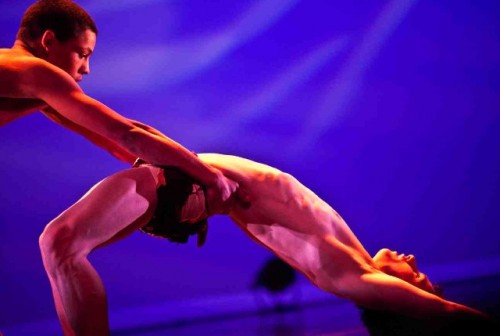Cisne Negro Dance Company at the Joyce Theater
On Tour from Brazil
By: Susan Hall - Aug 22, 2011
Cisne Negro Dance Company
Hulda Bittencourt, Founder and Artistic Director
The Joyce Theater
175 Eighth Avenue
New York
August 20, 2011
Photos by Matthew Murphy courtesy Cisne Negro.
Cisne Negro is one of South America’s leading modern dance companies. During a performance at the Joyce Theater in New York last week it was easy to see why. Rooted in classical ballet forms, the dancers’ moves range from classic positions to poses and gestures only a superb athlete could achieve. In familiar moves members of the company take off in unexpected and delightful tangents.
All of the talent of the troupe are put together by the choreographers Gigi Caciuleanu, Rui Moreira and Dany Bittencourt, the daughter of the group’s founder, Hulda.
The opening number Flock was set to Stravinsky’s music, a perhaps dangerous reference because it is iconic for the audience. The novel exploration of bird flight told a tale of black swans and red firebirds. Tutued men and women moved from arrestingly flapping gestures of great birds about to rise to sculptured arm positions. The dance is primitive and visceral and elevated all at once. Going with the flow of these firm and powerful dancers is pleasurable. Perhaps we were not meant to be literal about meaning. Certainly the visual impression was glorious.
Abacada is a title based on form, the ‘a following ‘b’, and ‘c’ and ‘d’ and always returning to the core ‘a’ idea, a rondo. The dance was so daring, the music by Andre Mehmari, so provocative that you hardly see the pattern, instead it is imprinted. In front of a jigsaw puzzle of light projected on the backstage wall, the dancers approach the main theme with different techniques and postures. Dany Bittencourt choreographs for the episodic comments on the basic theme in contrasting solos and duos. Imaginative approaches bound from floor to sky, with dips and pas de deux interwoven. It is an intriguing and delightful dance.
Calunga presented the characters of the traditional Brazilian procession called Maracatu, also the name of the rhythm and the dance involved in a procession. Carnival music and more formal marches combined to suggest the coming of the King, Chico Rei, a black king in the Congo who was captured with all his court and taken to Brazil by Portuguese slave dealers. Chico Rei bought the freedom of many slaves and created a free black community.
Focus here was on his wife who was swept into the sea and rose again as a Saint. In the final procession a doll is raised on high to symbolize Afro-Brazilians who carry on native African rites. If you knew this story, the choreography made sense. Its deep embedding in Brazilian culture must have made its story an easy read during performances at home.
Marcello Gomes, a friend of the company, and a principal dancer for the American Ballet Theater, presented a guest solo, Paganini. Gomes, a dancer of impeccable technique and stunning stage presence, had originally choreographed the piece for a ballerina of La Scala Ballet, but he has now re-done the piece for himself. He shared the stage with Charles Yang, a violinist who took up the Paganini challenge with aplomb. Gomes takes the Caprice in A minor, a consummate composition of the man who was regarded as the greatest of all violinists.
Yang offers to perform for Gomes who takes him up. As Gomes gets into the music, his dance seems inspired by the Paganini leaps and decoration.
Gomes is a consummate performer, but clearly he is more than that. To appear on stage in dialogue with a musician, to pick a piece which is the standard to which violinists aspire, and to create a playful, delightful challenge that Paganini himself would have appreciated, shows how far Gomes is willing to stretch his talent. A duet with a violinist is daring on the face of it.
Seeing any of the splendid talent on stage at the Joyce anywhere in the world is worth the effort. They are moving, beautiful dancers with zest and a taste for bringing the past into the future.




